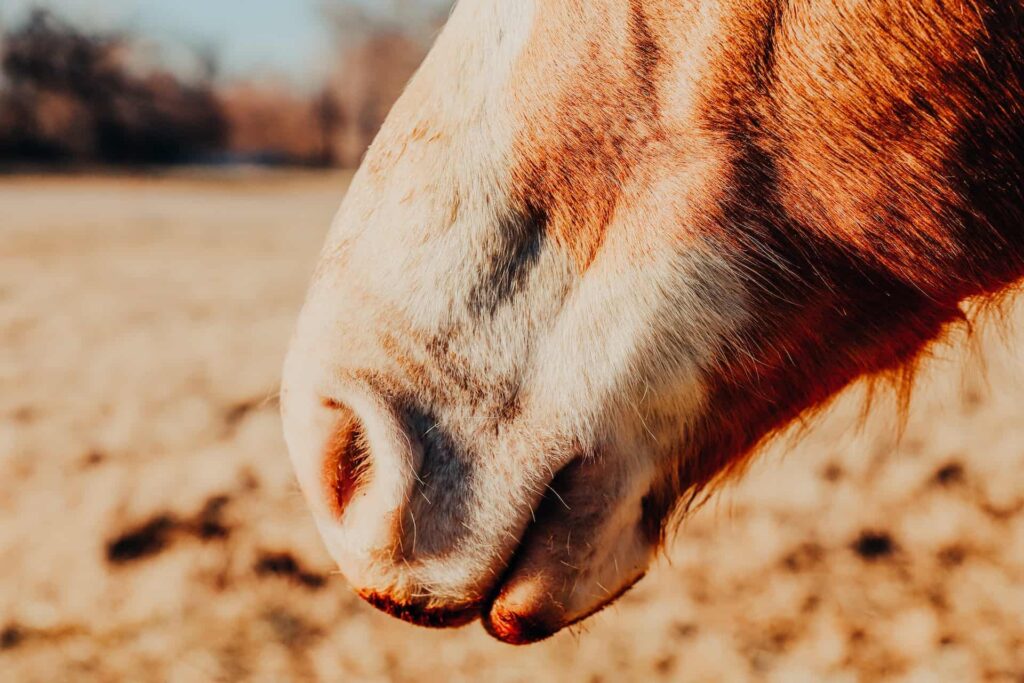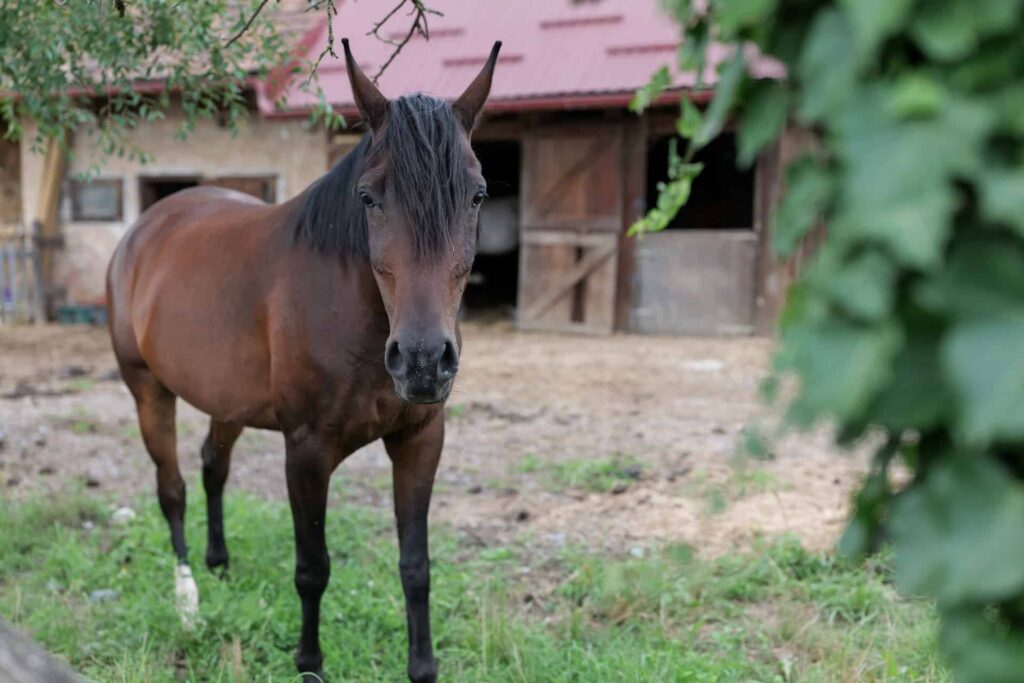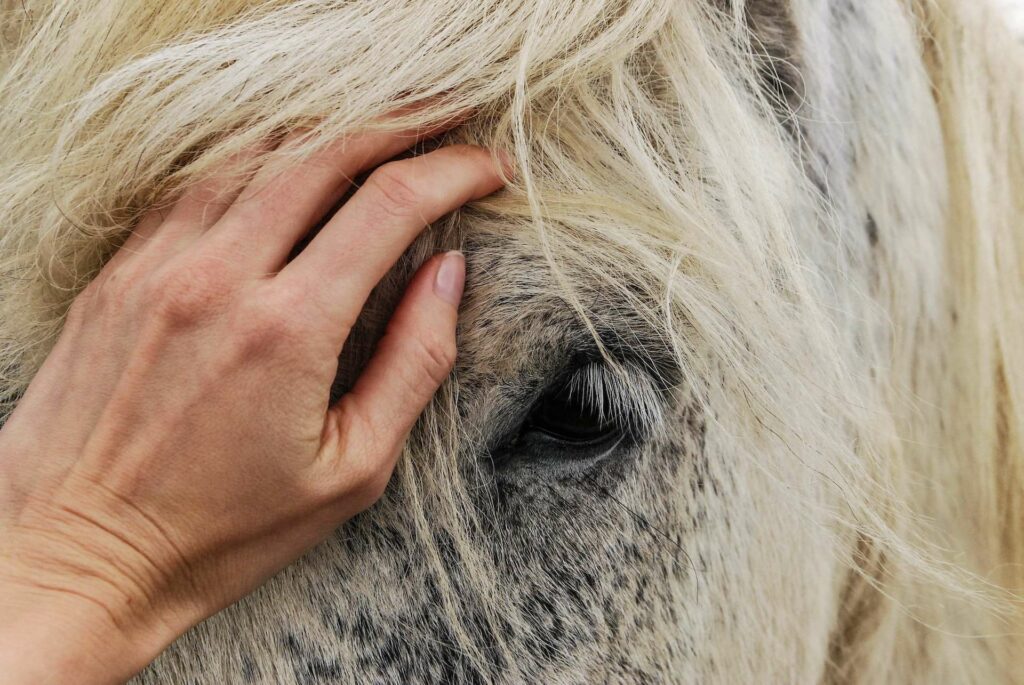Horse parasites are a significant concern for equine health, affecting horses of all ages, breeds, and backgrounds. They can reside internally, often inhabiting the digestive system, where they can cause a variety of health issues that range from mild discomfort to severe disease or even death. As parasitic infestations can compromise a horse’s well-being, understanding the types of parasites that affect horses, such as strongyles, ascarids, and pinworms, is crucial for effective management and treatment.
The life cycle and transmission of these parasites are complex and are influenced by factors like environmental conditions, grazing practices, and the behavior of the horse. Horses grazing in pastures are especially vulnerable to ingesting parasite larvae.
Therefore, routine diagnosis and monitoring are needed to identify and manage parasitic burdens effectively. Strategic control measures, which include a combination of anthelmintic treatments and environmental management practices, must be implemented to disrupt the life cycle of parasites and reduce the risk of infection.
Key Takeaways
- Equine parasites pose serious health risks and require vigilant management.
- Effective parasitic control combines treatment with environmental strategies.
- Regular monitoring is critical for maintaining horse health and preventing disease.
Types of Equine Parasites
Equine parasites are a common concern among horse owners, impacting the health and well-being of horses. The various parasites can be categorized broadly into internal and external types, with multiple species affecting different systems of the host.
Internal Parasites
Internal parasites, or endoparasites, affect the internal organs of horses. This group includes a variety of species, such as:
- Ascarids, or roundworms (Parascaris equorum), which are large, and primarily infect young foals, potentially causing respiratory and digestive issues. The eggs of ascarids are hardy and can survive in the environment for extended periods.
- Large strongyles (Strongylus vulgaris), once the most concerning internal parasite, are known to cause severe damage to the blood vessels and organs they inhabit.
- Small strongyles (Cyathostomins), which can encyst and remain dormant as larvae within the intestinal wall, make them more challenging to eliminate.
- Tapeworms (Anoplocephala perfoliata), contracted via intermediate hosts like oribatid mites, are linked to instances of colic.
- Pinworms (Oxyuris equi), which lay their eggs around the horse’s anus, causing itching and discomfort.
Other notable internal parasites include:
- Threadworms (Strongyloides westeri), primarily affect foals and cause diarrhea and weakness.
- Bots, the larvae of the botfly (Gasterophilus spp.), which can be found in the stomach and are ingested when horses lick at areas where botfly eggs have been deposited.
- Habronema, a type of stomach worm that can cause skin lesions when larvae are deposited in skin wounds by house or stable flies.
External Parasites
External parasites, or ectoparasites, live on the skin of the horse, feeding on blood or skin cells. Significant external parasites include:
- Botflies, are already mentioned as an internal threat due to their larvae, but as adults, these flies are also an external nuisance as they lay eggs on the horse’s coat.
- Gasterophilus, the botfly genus, encompasses several species that target horses, including G. intestinalis and G. nasalis.
While the list of equine parasites is extensive, consistent management strategies can control their impact on horse health. Proper deworming regimens and environmental management are foundational in preventing both internal and external equine parasites from becoming a larger issue.
Life Cycle and Transmission
Understanding the life cycle and transmission of horse parasites is essential for effective control and management. The two types of life cycles—direct and indirect—determine how parasites spread and the strategies necessary for their interruption.
Direct Life Cycle
In the direct life cycle, parasites such as Strongylus vulgaris and Parascaris equorum pass their eggs into the environment through the horse’s feces. These eggs then develop into larvae in the pastures, especially in warm, moist conditions. The larvae mature on the grass and are subsequently ingested by grazing horses. Once inside a new host, they mature into adults, and the cycle begins again. The role of environmental factors is crucial as they affect both the development of parasites and their subsequent transmission.
- Lifecycle Stages:
- Egg → Larva → Adult parasite within-host
- Transmission: Feces → Environment (grass/pasture) → Ingested
Indirect Life Cycle
The indirect life cycle involves an intermediate host, which is necessary for the parasites’ development before they can infect a horse. Parasites with these lifecycle stages typically are not as common in the horse population compared to those with a direct lifecycle. The manure of infected horses can contaminate the pastures, but the transmission of the parasites requires the presence of the intermediate host for the cycle to progress. These hosts can vary greatly depending on the parasite species.
- Lifecycle Stages:
- Egg/Larva → Intermediate host → Adult parasite within definitive host
- Transmission: Feces → Intermediate host environment → Ingested by horse
Disease Manifestation and Health Impact
Equine parasites can cause a variety of disease manifestations, impacting horse health in multiple specific ways. The health impact ranges from mild symptoms to severe issues that can affect the horse’s overall well-being.
Clinical Signs
In horses, clinical signs of parasitic infections vary widely but can include diarrhea, weight loss, a cough indicating respiratory system involvement, and nasal discharge. Of particular concern is colic, a serious symptom associated with parasitic damage to the gastrointestinal tract, particularly the large intestine and cecum. Signs of colic can range from mild abdominal discomfort to severe, life-threatening conditions.
Effects on Specific Organs
Parasitic infections in horses can lead to specific organ effects, with the liver being susceptible to damage that may lead to blood clots and other associated conditions. In the respiratory system, parasites may cause inflammation leading to a cough or discharge. Parasites targeting the gastrointestinal tract can impair nutrient absorption, crucial for maintaining the horse’s condition and preventing slow growth in younger animals.
Diagnosis and Monitoring

Diagnosing and monitoring equine parasites are critical for the effective management of horse health. They rely heavily on examining fecal samples for egg counts and scrutinizing the horse’s appearance for clinical signs.
Fecal Diagnostics
Fecal diagnostics play a pivotal role in identifying parasitic infections in horses. Central to this is the fecal egg count (FEC), which quantifies the number of parasite eggs per gram of feces. Performing a fecal flotation allows for a more targeted treatment regimen by determining the burden and types of parasites present.
- Fecal Egg Count: Provides crucial data on the parasite load.
- Fecal Flotation: Enhances detection of eggs through fecal sample concentration.
Techniques such as fecal egg count reduction testing help in assessing the efficacy of anthelmintic treatments and in detecting resistance.
Visual Appearance
The visual appearance of a horse can be indicative of parasitic infection. A rough hair coat or roughs in the coat can suggest poor health possibly attributed to a high parasite burden. Consequently, veterinarians often include a thorough external examination within their diagnostic protocol.
- Hair Coat: Should appear smooth and shiny; roughness can be a warning sign.
- Roughs: Patchy areas that lack the smoothness of the surrounding coat, warranting further investigation.
Additionally, clinical signs coupled with fecal diagnostics provide a comprehensive view for diagnosing equine parasites.
Parasite Control Strategies
Effective parasite control strategies are critical in maintaining horse health and preventing the development of resistant parasite populations. These approaches involve not just the use of chemical treatments but also the integration of management practices that hinder the life cycle of parasites.
Anthelmintic Treatments
Anthelmintic treatments refer to the usage of dewormers or wormers, which are chemical substances like ivermectin, praziquantel, pyrantel pamoate, fenbendazole, moxidectin, and oxibendazole. Veterinarians routinely recommend these treatments as part of a comprehensive parasite control program. The application of these medications can be tailored based on factors such as the age of the horse, the parasite load, and the time of year.
Resistance Management
Resistance management is a pivotal aspect of any parasite control strategy. It includes the monitoring of resistant parasites through fecal egg count reduction tests. Modifying deworming schedules to focus on treatment when necessary, rather than adhering to a strict interval, can also reduce the chance of resistance developing. Interaction with a trained veterinarian is crucial for devising a program that reduces anthelmintic resistance.
Non-Chemical Practices
Non-chemical practices play an essential role in controlling parasites and reducing the reliance on anthelmintics, thereby decreasing the chances of developing resistance. Key methods include:
- Pasture management: Strategies involve regular manure removal, rotational grazing, and avoiding overstocking pastures to minimize the risk of parasite transmission.
- Environmental control: This encompasses managing the conditions around the stable to decrease the parasite load in the environment.
- Immunity focus: Ensuring horses live in a healthy environment can naturally boost their immunity against parasitic infections.
Preventive Measures and Environmental Management
Effective management of equine parasites requires strategic planning that includes rigorous pasture management and careful herd health oversight. By prioritizing cleanliness and adopting a systematic approach to resource use, such as rotation and manure management, the incidence of parasitic infections can be controlled, contributing to the overall well-being of horses in varying climates.
Pasture Management
- Cleanliness & Rotation: Regularly cleaning pastures and employing a strategic rotation schedule can greatly reduce the parasite burden. It’s essential to avoid overgrazing and to allow pastures sufficient rest periods to disrupt the life cycles of common parasites.
- Manure Management: Diligent removal and proper disposal of manure are vital. Composting can effectively reduce the viability of parasite eggs and larvae if managed correctly.
Key Measures:
- Rest pastures to break parasite life cycles.
- Cross-graze with other species like sheep or cattle to help reduce equine parasites, which don’t typically affect other livestock.
- Test soil and manage resources thoughtfully by considering local climate and resources when planning pasture rotation and forage availability.
Herd Health Management
- Deworming & Foals: An evidence-based approach to deworming is recommended, adjusting schedules to the specific needs of individual horses, such as foals, which require more frequent treatments.
- Monitoring Mares & Environmental Conditions: Mares and other vulnerable horses should be monitored closely, especially under high-stress conditions. Climate changes can affect parasite prevalence and must be factored into herd health strategies.
Herd Health Strategies:
- Conduct fecal egg counts to tailor deworming protocols to individual horses.
- Provide quality hay and feed to maintain herd health, particularly for pregnant mares.
- Isolate new arrivals until they have been checked and treated for parasites to prevent infection spread.
By implementing these proactive measures, the health and well-being of horses can be safeguarded against the threat posed by parasitic infections.

The Role of the Equine Community
The equine community plays a pivotal role in managing and controlling equine parasites. Through education, horse owners and equine professionals become informed about the risks parasites pose and the importance of strategic deworming programs. Initiatives such as workshops and seminars can elucidate the dangers of over-reliance on anthelmintics and the rising issue of anthelmintic resistance.
Awareness is another critical aspect where the community’s involvement is essential. Equine enthusiasts and caretakers need to be aware of the signs of parasitic infections and understand the life cycles of common parasites. This knowledge leads to better decision-making when it comes to preventative measures and treatment, ensuring the well-being of horses and reducing the spread of internal parasites like strongylids, as highlighted in a research study.
Collaboration among veterinarians, researchers, and horse owners is necessary to establish effective parasite control strategies. Shared experiences and data about parasite burdens can contribute to the development of tailored deworming programs. By combining forces, the equine community can also promote sustainable parasite control, which can be adapted to various environments and management practices, much like those examined in sustainable parasite control research.
Effective parasite management relies on the equine community’s engagement in continuous learning and adaptation to new control methods. By prioritizing the health of their horses through informed practices, the equine community ensures both the longevity of their animals and the efficacy of parasite control measures for the future.
Frequently Asked Questions
Equine parasitic infections have distinct signs and treatment approaches. Understanding these can significantly impact horse health and management.
What are the common signs of parasitic infection in horses?
Signs of parasitic infection in horses may include colic, diarrhea, weight loss, and poor coat condition. A high worm burden can lead to significant health issues and may be indicated by a pot-bellied appearance in younger horses.
How can one identify different types of equine worms from horse manure?
Different types of equine worms, such as roundworms, tapeworms, and strongyles, can sometimes be seen in horse manure, but many are too small to detect without a microscope. Fecal egg count tests are typically conducted to identify the types and levels of infestation.
Which parasites are considered the most harmful to equine health?
Large strongyles, or bloodworms, are considered one of the most dangerous parasites due to their potential to cause severe intestinal damage. Small strongyles, tapeworms, and roundworms also pose significant risks to a horse’s well-being.
What are the treatment options for eliminating parasites in horses?
Treatment includes the use of anthelmintics or dewormers, which should be selected based on the type of worms present and the degree of infestation, with the guidance of a veterinarian.
How often should horses be screened and treated for internal parasites?
The frequency of screening and treatment varies depending on factors such as age, immune status, and environmental conditions. Most horses should undergo a fecal egg count at least twice a year to tailor deworming strategies appropriately.
What preventative measures can be taken to reduce the risk of parasitic infection in horses?
Preventative measures include implementing good pasture management practices, avoiding overcrowding, rotating pastures, and regular manure removal to interrupt the lifecycle of parasites. Environmental management is key to reducing exposure and infection rates.
Last Updated on December 13, 2023 by Nate Dewsbury



